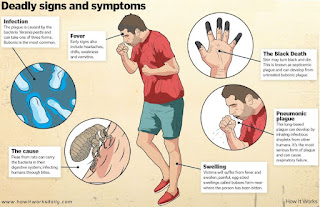Are You a Novid, or COVID Super-Dodger—Someone Who's Never ...
Is The Bubonic Plague Still Around?
The plague. Sounds like one for the history books, right? Well, believe it or not, the plague is still around.Blame fleas and the rats, mice, chipmunks, and squirrels they infect. Bubonic plague is caused by bacteria that live in fleas. If you get bit, you can get it, too. You can even get it from a rodent that a flea bites.
Symptoms can start two to six days after being exposed. People get flu-like symptoms like a fever, headache, weakness, and swollen lymph nodes. And large lymph nodes are called buboes, which is where the bubonic plague gets its name.
Plague is rare, because thankfully, we have much better ways to control rodents these days. And unlike in the Middle Ages, millions of people don't die from plague anymore. That's because doctors can cure it with antibiotics.
The sooner it's treated, the better the odds of a full recovery.
For WebMD, I'm Dr. Michael Smith.","publisher":"WebMD Video"} ]]>
Hide Video Transcript
MICHAEL SMITH
The plague. Sounds like one for the history books, right? Well, believe it or not, the plague is still around.Blame fleas and the rats, mice, chipmunks, and squirrels they infect. Bubonic plague is caused by bacteria that live in fleas. If you get bit, you can get it, too. You can even get it from a rodent that a flea bites.
Symptoms can start two to six days after being exposed. People get flu-like symptoms like a fever, headache, weakness, and swollen lymph nodes. And large lymph nodes are called buboes, which is where the bubonic plague gets its name.
Plague is rare, because thankfully, we have much better ways to control rodents these days. And unlike in the Middle Ages, millions of people don't die from plague anymore. That's because doctors can cure it with antibiotics.
The sooner it's treated, the better the odds of a full recovery.
For WebMD, I'm Dr. Michael Smith.
latest videos on Health A-ZLoad More
Bronze Age Plague

The team sequenced the genomes of Y. Pestis recovered from two Bronze Age skeletons—one male and one female—buried together in southwestern Russia. They determined that the strain with which the pair was infected had developed mutations that allowed it to be carried by fleas. Researchers are unsure how earlier known strains of the bacterium were spread, but they are certain that fleas spread plague efficiently, allowing it to reach pandemic levels. "We know of a lot of historical outbreaks of disease for which the causes have not yet been identified," says Maria Spyrou of the Max Planck Institute for the Science of Human History. "Now that we know that Y. Pestis has been capable of causing epidemics in humans for the past 4,000 years, we have to start screening more material to determine whether it could have been involved." The team hopes to find evidence of early plague outbreaks that have gone unrecorded.

Shubayqa, Jordan

Blomboschfontein Nature Reserve, South Africa

Prêles, Switzerland

Samara, Russia

Florence, Texas

Olympia, Greece

Pompeii, Italy

Saqqara, Egypt

Denisova Cave, Russia

Black Sea
'Racism In Medieval England' May Have Led To Black People Dying Of Bubonic Plague
Racism in medieval England may have contributed to black people dying of bubonic plague, academics have suggested.
Researchers employing "black feminist archaeology" have studied remains in 14th-century plague cemeteries in London.
The study has claimed that black people may have succumbed to the plague in disproportionate numbers compared to whites because of "structural racism" in medieval England.
It concludes that critical race theory, an academic field devoted to examining how Western institutional power upholds racism, should be used by archaeologists in future.
Research conducted by Dr Rebecca Redfern, of the Museum of London, also suggests that "misogynoir", prejudice against black women, created a particular risk of death by plague.
The study suggests that the findings show "structural racism's devastating effects" at work in 14th-century England, when the plague bacteria yersinia pestis caused mass death.
Dr Redfern studied 145 sets of human remains interred in plague cemeteries when the Black Death swept through London and killed about 35,000 people. Of those buried, 49 succumbed to plague and 96 to other causes.
By measuring skull features, Dr Redfern and her colleagues claimed to have established that there were nine people of black African ancestry among the plague dead, and eight among the others.
'Black population suffered disproportionately'Dr Redfern's research paper, published in Bioarchaeology International and focusing on "anti-black structural racism", claims that the purported black population in London suffered disproportionately more deaths during the plague which struck in 1348.
The paper cites studies that show death by plague was more likely for those with underlying nutritional or health problems, perhaps caused by poverty or other stresses, and concludes that the black population of medieval London may have suffered the "health outcomes of structural and anti-black racism".
The paper models the number of females of African descent in the graves, and concludes that they had health outcomes that were worse still, amid a pestilence that killed a third of the population of Europe.
The paper states: "Intersectionality – the compounded harm of race and gender and misogynoir – may have impacted mortality during medieval pandemic disease." The recent neologism "misogynoir" is a portmanteau of "misogyny" and the French word for black, "noir".
The paper makes apologies for the disciplines of its authors and the "double whiteness" and "twinned whiteness of both anthropology and medieval studies", and states that it has set out to "prioritise the methodologies of black feminist archaeology".
This theoretical approach to archaeology seeks to focus on race, class, gender, and inequality, including in prehistory.
The paper concludes: "We recommend that intersectionality and critical race theories become integrated" into archaeological studies, with intersectionality being the crossover of various traits such a race and class which could lead to inequality.
Dr Redfern has based her conclusions on research into the non-white population in medieval London, a population that she claims made up 30 per cent of the sample population in the plague burial sites.
Their ancestry is based on forensic studies of their skull features, and comparisons with modern populations their skulls appear similar to, a method which has proved controversial.
Studies of the skull of the Roman-era remains of Beachy Head Lady in East Sussex suggested she was of sub-Saharan African ancestry, before DNA testing revealed she was in fact from Cyprus.
It is understood the Museum of London will not conduct any DNA testing into the plague burial remains.
The diversity of Britain has become a prominent issue, and a number of claims about the racial makeup of past populations have been disputed.
'Every single Briton comes from a migrant'A book titled Brilliant Black British History was criticised for its claim that "every single British person comes from a migrant" and that black people built Stonehenge.
Genetic studies have shown that the inhabitants of Britain in the period when Stonehenge was completed, around 2,500 BC, were pale-skinned early farmers whose ancestors had spread from Anatolia.
Broaden your horizons with award-winning British journalism. Try The Telegraph free for 1 month, then enjoy 1 year for just $9 with our US-exclusive offer.



Comments
Post a Comment